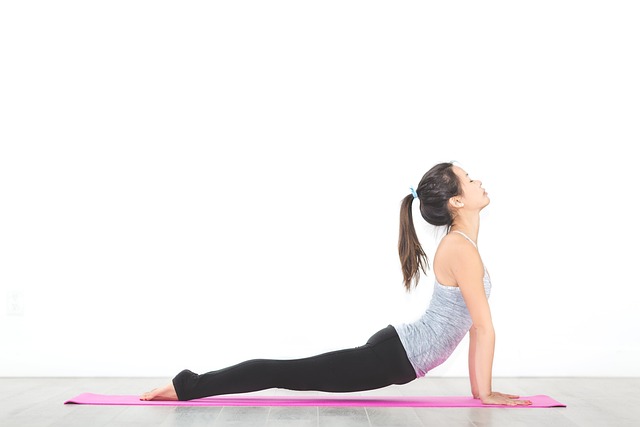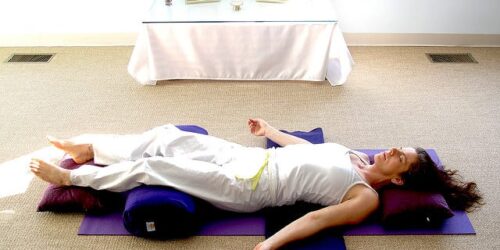Should You Do Yoga Before Or After Workout? The Ultimate Guide
So should you do yoga before or after a workout? Well, it all depends on a wide range of variables. Yoga is recommended as a post-workout activity, for instance, if you’re about to lift weights.
Anyone who is interested in yoga has probably made some connections with the fitness industry or vice versa. Yoga is the ideal addition to your gym workout regimen, whether you’re looking to build your ideal body or are just looking for some mental stability.
However, this does not imply that you should immediately start a high-intensity workout or weightlifting session by hitting the mat. In fact, studies suggest that doing this might work against your efforts to get in shape.
In this article, we’ll go into great detail about how to schedule your yoga practice in conjunction with your other workouts.
Table of Contents
Should I Do Yoga Before Or After a Workout?
Generally, the answer to whether you should do yoga before or after workout sessions is to do it after. In fact, by scheduling it on a different day from your workouts, you might get even more benefit from it.
Why?
Your muscles, fascia, and other tissues are typically weaker after the session, which is a significant factor. This is especially true when practicing poses that last for a long time and doing lengthy stretches.
As a result of the weakened body tissues, you might not be able to exert yourself as much during your workouts.
This should be a top priority if your exercises call for a lot of strength.
The strength of muscles comes from their capacity to contract. But yoga lengthens your muscles to new levels, which makes them less able to contract.
The ability to contract your muscles will not return for several hours. That implies that you shouldn’t start working out right away after the session.
Why I Shouldn’t Do a Yoga Class After a Workout?
Maybe you still need more convincing as to whether you should practice yoga before or after your workouts.
Here are a few more justifications for why you shouldn’t do it before exercise to help you understand this problem.
Stretching before a workout is not always beneficial, according to numerous studies. Stretching is typically involved, so doing this before exercise might not benefit your workout.
Contrary to what you may assume, pre-workout stretching may not help in:
- curbing muscle soreness after your workout
- preventing injury
- improving performance
Stretching can also impair your performance.
Static stretching during your yoga practice will probably result in a temporary loss of muscle strength. If you maintain the static stretch for longer than 45 seconds, your muscles will be affected even more.
However, it might benefit your workout if it only involves dynamic stretches. With dynamic stretches, you don’t hold the stretch; instead, you keep moving the affected body part. This is particularly helpful if the dynamic stretches are less intense variations of your workout movements.
Why I Should Do Your Yoga Practice Post-Workout?
Attending a yoga class right after working out is much more advantageous.
Yoga, which can facilitate the body and mind’s transition from intense exercise to a regular period of rest, is a great activity to engage in now.
Here are some of the benefits of practising yoga after exercise:
Enhanced Muscle Recovery
Yoga helps the muscles recover after a workout by increasing blood flow to the muscles. Your active tissues receive vital nutrients and oxygen from the increased blood flow. In fact, this helps muscles recover more quickly from a strenuous training session.
Increases Flexibility
Muscles are composed of interlocking fibers, as you are probably aware. The act of shortening a muscle simply involves those fibers passing next to one another. After exercise, some muscles may continue to be contracted, resulting in tightness and stiffness.
Yoga can be useful in these situations.
All of your muscles can be fully stretched out with yoga. Consistent stretching results from the realignment of the muscle fibers. The muscles are now able to heal more quickly and efficiently in that situation.
Regular stretching of the muscles will gradually increase their flexibility. Flexible muscles are less prone to injury and put less pressure on the joints. In addition to reducing your risk of injury, practicing yoga can help you avoid developing osteoarthritis in your joints.
Reduces Cortisol & Blood Sugar Levels
Workouts of moderate to high intensity will raise cortisol levels in the body. This is a naturally occurring stress hormone, and high levels of the hormone can cause:
- Weakens the immune system
- Elevate your blood pressure
- Causes muscle weakness and wasting
- Increases your risk of developing diabetes
Fortunately, a regular yoga practice can assist in lowering cortisol levels in the body.
Yoga has the added benefit of reducing blood sugar levels, which is a benefit that you can also enjoy after your workout. This lessens the effect of quick, intense workouts that raise blood sugar levels.
The body becomes more responsive to insulin with regular exercise. This enables your muscles to receive more blood sugar. Additionally, high blood sugar levels make your pancreas’ insulin-producing cells more susceptible.
You can eventually manage or even prevent diabetes thanks to yoga’s impact on blood sugar.
Reduces Your Heart Rate
The heart rate increases during exercise. You need to return your pulse to its normal resting rate as a result. Yoga’s emphasis on slow, deep breathing can be helpful in this regard.
Deep breathing activates the body’s vagus nerve. This is crucial for the parasympathetic nervous system, which reduces your heart rate to conserve energy. This behavior interferes with the stress-producing effects of exercise on your sympathetic nervous system.
As a result, blood pressure drops and heartbeats slow down. Repeated practice will maintain this effect, which also helps those who have heart disease.

Is It OK to Do Yoga Before a Workout?
A few yoga stretches prior to working out can also be a great way to warm up and get your blood flowing. Yoga can be used as a stand-alone workout as well as a great way to cool down and stretch the muscles worked in an intense training session.
To get the most out of yoga before your workout, you’ll want to opt for a gentle vinyasa flow or a few rounds of sun salutations, rather than relaxation poses like savasana, which will make you want to snooze rather than hit the weights. Dynamic stretches help you warm up your muscles and raise your heart rate before your workout.
Yoga practice before a workout is most advantageous for certain sports or training sessions that emphasize flexibility over strength.
Pros of Adding Yoga to Your Workout Routine
There are two primary reasons you might be asking: Before or after a workout should I practice yoga? You are either a dedicated yogi looking to balance out your fitness routine with other types of exercise, or you are an active participant in other types of exercise and are looking to add yoga.
If it’s the former, you’re probably already aware of the advantages of yoga, but if it’s the latter, it’s useful to briefly discuss the advantages of incorporating yoga into your exercise regimen.
Choosing whether to practice yoga before or after your workout can be influenced by your understanding of the advantages of incorporating the practice into your fitness regimen.
Studies have shown that a consistent yoga practice can increase flexibility and mobility, reduce chronic pain and back pain, improve breathing, strengthen the entire body, improve balance and posture, increase circulation, and reduce stress and anxiety.
Pros of Doing Yoga After a Workout
Even though perhaps your first inclination after finishing running or doing a sweat-dripping cardio workout is to guzzle a full bottle of water or sports drink, take a shower, and then put your feet up and relax, taking some time to roll out your yoga mat and doing a few poses can afford a variety of mental and physical benefits, including the following:
Great Cool-Down After Cardio
After cardio, practicing yoga helps you bring your heart rate and respiration rate back down. Your heart beats much faster and harder during cardio exercise than it does at rest in order to supply your working muscles with the oxygen they require. Examples of this include running, cycling, swimming, rowing, and other forms of cardio.
Your heart rate will drop if you immediately transition from vigorous cardio to a shower or resting, which could cause blood to collect in your lower extremities. Not only can this make you dizzy, but it can also make you more likely to experience DOMS in the days after your workout.
The cardiovascular transition from a state of high activity to rest is facilitated by doing yoga after running or cardio.
Reduce Muscle Soreness
Yoga as a cool down after cardio reduces your heart rate more gradually while still perfusing your muscles with blood. This aids in the removal of metabolic waste products left over from strenuous exercise and transports reparative nutrients and oxygen, which can lessen soreness.
In fact, studies show that incorporating yoga into your workout routine can reduce DOMS.
Increase Flexibility
The muscles and connective tissues around a joint are lengthened and stretched in many yoga poses. Yoga has been demonstrated to improve flexibility in this manner.
Yoga is best practiced after a workout because holding poses is most comparable to static stretching.Yoga before a workout may affect your ability to perform well during the workout because research suggests that static stretching can momentarily lower strength output.
Ideally, your warmup routine should involve dynamic stretching and your cool down should focus on static stretches such as yoga poses.
Boosts Well-Being
Yoga has been proven to enhance mood, lessen depressive symptoms, ease stress and anxiety, and foster a sense of general well-being.
When you practice yoga as part of your cool-down after a challenging workout, you can reflect on your workout, connect with your breath and body, calm your mind, center your thoughts, and approach the rest of the day with a positive attitude.
Pros of Doing Yoga before a Workout
There are some advantages to practicing yoga before getting on the treadmill or starting a set of challenging squats, even though it’s generally preferable to do it after a workout. Benefits of doing yoga before a workout include the following:
Eases You into Exercise
Let’s face it: starting a challenging workout can be difficult or unmotivating from a mental standpoint. We all experience days when we have to fight the voice in our heads that begs us to skip the workout and binge watch something on Netflix instead due to being overtired and overcommitted.
Rolling out a yoga mat and working through a few warm-up poses can ease the transition into a hard workout and can get you in the right headspace to focus and push yourself. Before a workout, yoga can be a simple way to get you moving. Once you get going, you’ll be more motivated and mentally prepared to take on more strenuous exercise.
Increase Your Mind-Body Connection
Increased body-mind awareness and a stronger sense of connection to your breath are two advantages of yoga.
Yoga practiced before a workout may enhance coordination, breath control, and core activation for the duration of the workout.
Warm Up Muscles
While holding yoga poses for a long time is similar to static stretching and is therefore likely counterproductive before a workout, if you do yoga more along the lines of dynamic stretching, it can be a useful part of your warmup routine.
In order to prepare your muscles for exercise, dynamic stretching increases blood flow to them. Additionally, it aids in boosting body temperature, warming up tissues, and raising heart rate so that you don’t immediately transition from a cold and resting state to vigorous jump squats, running, or other highly-active and taxing exercise.
If you decide to practice yoga before working out, move through the poses quickly, alternating between them in a fairly quick flow to simulate dynamic stretching. Warming up before a workout can be accomplished by performing yoga poses like cat-cow.
Yoga and Gym on Alternate Days
Contrary to what many people think, yoga can be an excellent standalone full-body workout. Instead of having to decide between yoga and the gym, schedule them on different days for the best results.
There is a ton of proof that yoga helps you get stronger, toned, and more flexible while burning tons of calories. The key is picking the appropriate yoga style. Your decision about when to do yoga ultimately comes down to your fitness goals:
- If you are trying to bulk upyour muscle, try doing moderate intensity yoga on your rest days from the gym.
- If you are trying to lose weight, opt for a more intensive Workout on your own with Ashtanga or Power Yoga.
- If you want to use yoga as part of your pre workout stretching, choose dynamic medium-intensity flows like Vinyasa.
- If you want to stretch out some major delayed onset muscle soreness in the 24-48 hours after your workout, do On your rest days, practice Yin yoga or deep yoga stretches.
Yoga class and the gym should ideally be scheduled on different days if you really want to do both. Taking up yoga in the morning and working out in the evening are two examples.
Even better, spend the morning working out at the gym and the afternoon at the studio. In this manner, you give your muscles plenty of time to rest and recover between yoga practice and exercise.
Moral of the Story
The bottom line is that taking a yoga class will always be good for your mental and physical health. If you want to incorporate yoga into your workout routine to maximize your performance, it’s probably best that you do yoga after the gym or on a separate day altogether.
Stretching before exercise isn’t always beneficial, according to research. But it is undeniable that stretching after a workout is crucial for reducing muscle soreness, enhancing range of motion, preventing injuries, and ultimately assisting in the long-term development of muscle strength.
Why not coordinate your yoga practice with your weight training objectives to reap the benefits of both?
Namaste!
FAQs
Is It Bad to Do Yoga before Working Out?
It is not recommended to do yoga before your workouts. In many yoga poses, static stretching is used to maintain the same position for extended periods of time. This static hold actually puts stress on your fascia and muscle fibers, lowering your workout performance.
If you do yoga after the gym, you are more likely to reap the benefits of both a yoga practice and your gym workout.
Should I Do Yoga Or Weights First?
It is best to practice yoga after a workout or on your days off. This is due to the fact that yoga lengthens your muscle fibers and lowers their capacity to contract. Contraction is actually what builds muscle, so the weakened body tissues from doing yoga before a workout ultimately reduce your weight training performance.
Lift weights first, always. Dynamic stretches like Vinyasa flows or Sun Salutations are good choices if you prefer to stretch before lifting weights. Just be careful not to hold your poses for too long or put undue strain on your muscles, which could hinder your workout performance.
Read about Can Yoga Make You Taller?





